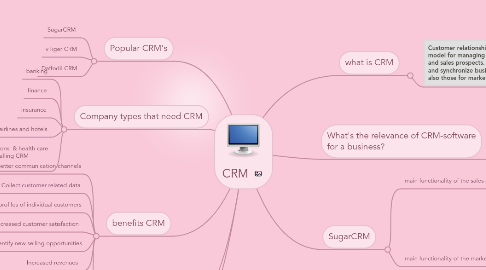
1. Types
1.1. Operational CRM
1.2. Analytical CRM
1.2.1. The data collected in operational management is analyzed to segment customers. The valuable information thus obtained is used to satisfy customers.
1.2.2. Analytical CRM is composed of:
1.2.2.1. Pattern discovery component
1.2.2.2. Product and customer analysis component
1.2.2.3. Multitude component
1.2.2.4. Sorting and customer fractionation component
1.2.2.5. Customer value evaluation component
1.2.3. Examples
1.2.3.1. data warehousing, online analytical processing (OLAP), and data mining systems.
1.3. Operational CRM
1.3.1. The operational application of CRM enables effective interaction with customers. For this purpose various tools are used. These contact management tools aim to reduce costs by improved process efficiency and use of media based communication channels. These are also aimed to provide customers with a consistent interface across all communication channels. To achieve this relevant customer data is collected and also displayed at all customer touch points.
1.4. Collaborative CRM
1.4.1. The various departments of company like the sales, technical support, and marketing, share the information they collect about customers. The objective is to improve the quality of customer service and increase customer loyalty.
1.4.2. It allows the company to synchronize and manage efficient, productive interaction with customers, prospects, partners, and internal associates across all communication channels. The customers' viewpoint is taken care of at every transaction level thus enabling better service to the customer. Collaborative CRM also reduces web service costs by enabling web collaboration.
2. Company types that need CRM
2.1. banking
2.2. finance
2.3. insurance
2.4. airlines and hotels
2.5. telecommunications & health care benefit from installing CRM software.
3. benefits CRM
3.1. Develop better communication channels
3.2. Collect customer related data
3.3. Create detailed profiles of individual customers
3.4. Increased customer satisfaction
3.5. Identify new selling opportunities
3.6. Increased revenues
3.7. Improved customer service and support
4. goals
4.1. the overall goals are to find, attract, and win new clients, service and retain those the company already has, entice former clients to return, and reduce the costs of marketing and client service
5. Popular CRM's
5.1. SugarCRM
5.2. vTiger CRM
5.3. Daffodil CRM
6. what is CRM
6.1. Customer relationship management (CRM) is a widely implemented model for managing a company’s interactions with customers, clients, and sales prospects. It involves using technology to organize, automate, and synchronize business processes—principally sales activities, but also those for marketing, customer service, and technical support.
7. What's the relevance of CRM-software for a business?
7.1. it's a technology that helps organise business processes lik marketing, sales,..
8. SugarCRM
8.1. main functionality of the sales page?
8.1.1. Sales forecasting- The sales manager can calculate potential sales and associated revenues based on projections from sales representatives, thus have a better control over performance, commitment, achieving realistic goals, and planning resources.
8.2. main functionality of the marketing page?
8.2.1. Campaign and Project Management- The campaign management tool allows users to organize marketing activities, manage and track marketing efforts on leads, contacts, and opportunities. The project management tool enables the users to define steps, establish timelines, and assign work to members on any project useful to end users.
8.2.2. Email marketing- The marketing team creates the email templates, the recipients are listed and they are sent personalized email templates as per the planned schedule.
